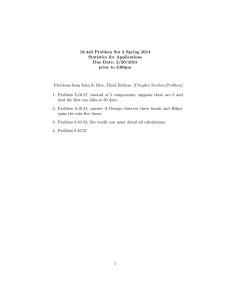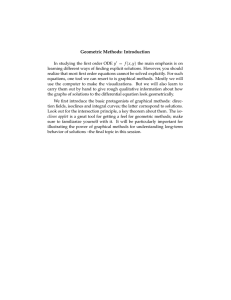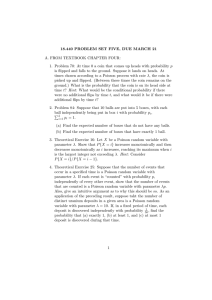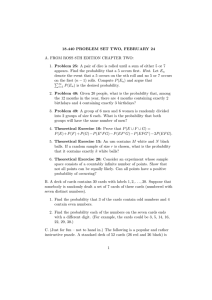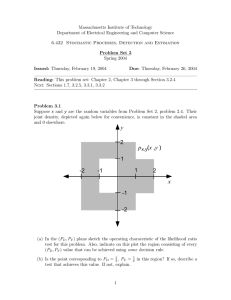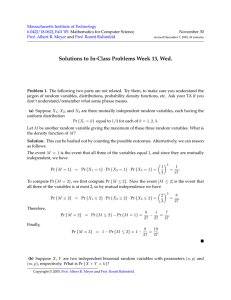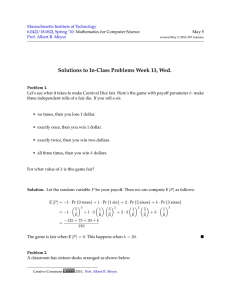In-Class
advertisement
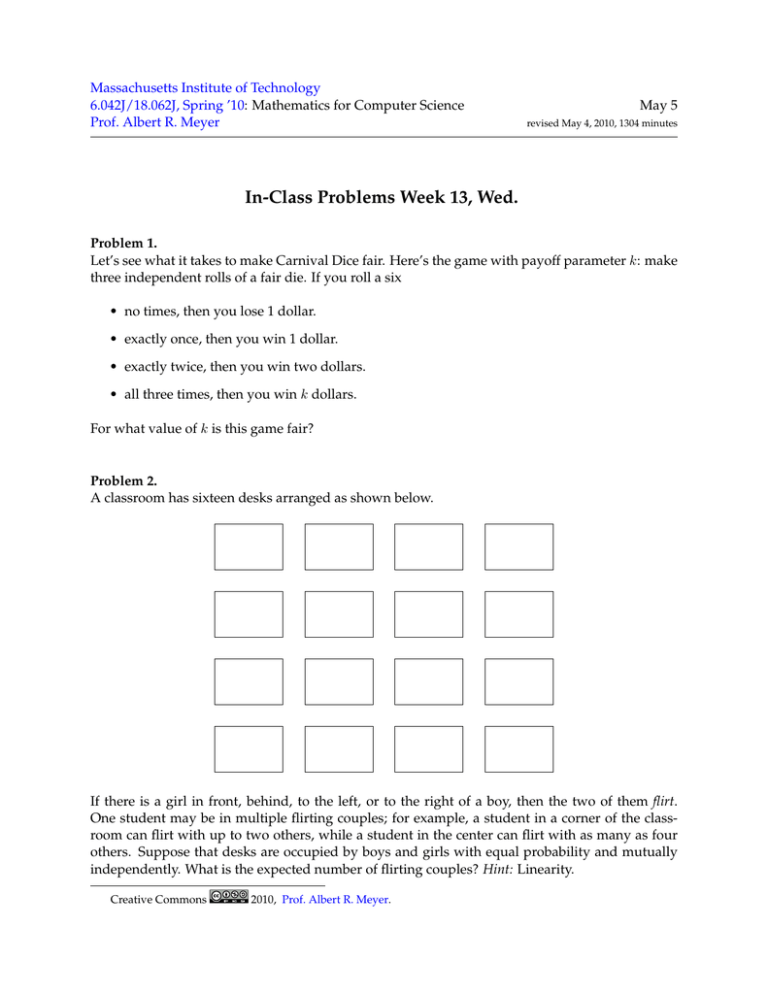
Massachusetts Institute of Technology
6.042J/18.062J, Spring ’10: Mathematics for Computer Science
Prof. Albert R. Meyer
May 5
revised May 4, 2010, 1304 minutes
In-Class Problems Week 13, Wed.
Problem 1.
Let’s see what it takes to make Carnival Dice fair. Here’s the game with payoff parameter k: make
three independent rolls of a fair die. If you roll a six
• no times, then you lose 1 dollar.
• exactly once, then you win 1 dollar.
• exactly twice, then you win two dollars.
• all three times, then you win k dollars.
For what value of k is this game fair?
Problem 2.
A classroom has sixteen desks arranged as shown below.
If there is a girl in front, behind, to the left, or to the right of a boy, then the two of them flirt.
One student may be in multiple flirting couples; for example, a student in a corner of the class­
room can flirt with up to two others, while a student in the center can flirt with as many as four
others. Suppose that desks are occupied by boys and girls with equal probability and mutually
independently. What is the expected number of flirting couples? Hint: Linearity.
Creative Commons
2010, Prof. Albert R. Meyer.
2
In-Class Problems Week 13, Wed.
Problem 3. (a) Suppose we flip a fair coin until two Tails in a row come up. What is the expected
number, NTT , of flips we perform? Hint: Let D be the tree diagram for this process. Explain why
D = H · D + T · (H · D + T ). Use the Law of Total Expectation 20.3.5
(b) Suppose we flip a fair coin until a Tail immediately followed by a Head come up. What is the
expected number, NTH , of flips we perform?
(c) Suppose we now play a game: flip a fair coin until either TT or TH first occurs. You win if TT
comes up first, lose if TH comes up first. Since TT takes 50% longer on average to turn up, your
opponent agrees that he has the advantage. So you tell him you’re willing to play if you pay him
$5 when he wins, but he merely pays you a 20% premium, that is, $6, when you win.
If you do this, you’re sneakily taking advantage of your opponent’s untrained intuition, since
you’ve gotten him to agree to unfair odds. What is your expected profit per game?
Problem 4.
Justify each line of the following proof that if R1 and R2 are independent, then
E [R1 · R2 ] = E [R1 ] · E [R2 ] .
Proof.
E [R1 · R2 ]
�
=
r · Pr {R1 · R2 = r}
r∈range(R1 ·R2 )
=
�
r1 r2 · Pr {R1 = r1 and R2 = r2 }
ri ∈range(Ri )
=
�
�
r1 r2 · Pr {R1 = r1 and R2 = r2 }
r1 ∈range(R1 ) r2 ∈range(R2 )
=
�
�
r1 r2 ·
Pr {R1 = r1 } · Pr {R2 = r2 }
r1 ∈range(R1 ) r2 ∈range(R2 )
⎛
=
�
⎝r1 Pr {R1 = r1 } ·
r1 ∈range(R1 )
=
⎞
�
�
r2 Pr {R2 = r2 }⎠
r2 ∈range(R2 )
r1 Pr {R1 = r1 } · E [R2 ]
r1 ∈range(R1 )
= E [R2 ] ·
�
r1 Pr {R1 = r1 }
r1 ∈range(R1 )
= E [R2 ] · E [R1 ] .
�
MIT OpenCourseWare
http://ocw.mit.edu
6.042J / 18.062J Mathematics for Computer Science
Spring 2010
For information about citing these materials or our Terms of Use, visit: http://ocw.mit.edu/terms.
